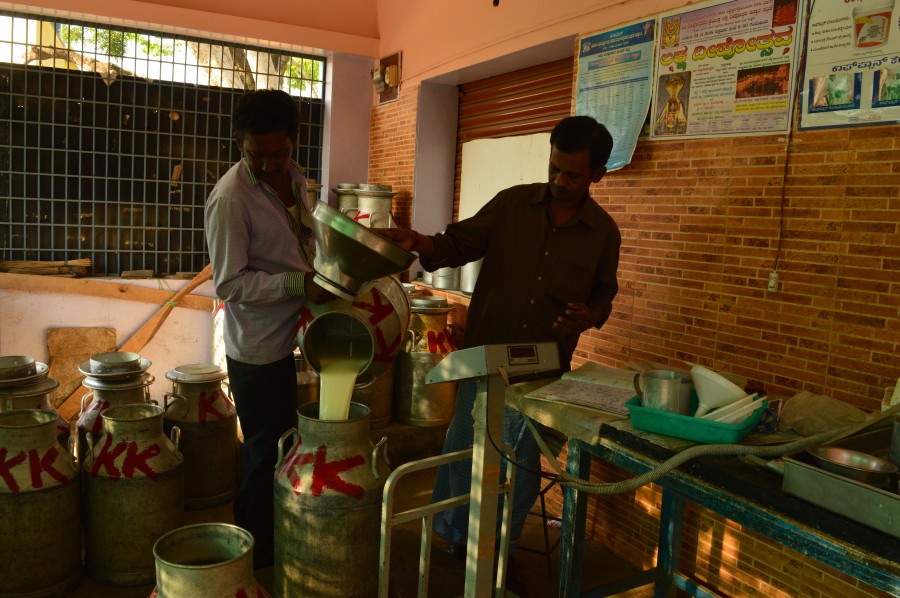
Water-starved Kolar, Chikkaballapur farmers start a white revolution

The twin districts of Kolar and Chikkaballapur were known for their mulberry cultivation and vegetable production, which catered to the burgeoning Bengaluru population. But with recurring droughts resulting in severe water scarcity and depleting ground water resources, some farmers quit agriculture and migrated to cities, while others slowly shifted to dairy farming to gain a stable income.
Ravindra N, a farmer in Kodikannur village in Kolar, says he used grow mulberry and vegetables in his seven-acre land until 2013, but now he’s restricted farming to less than half the area he owns (three acres) and increased his dependency on dairy farming. “This is the only way farmers get income every 15 days. Of the four cows I own, I milk two of them and earn ₹16,000 on an average a month,” Ravindra said.
While getting water and fodder for the cattle is a concern during summer in the water-scarce areas, farmers manage to lay their hands on borewell water or tanker water. Ravindra plans to get two more cows after summer. In Kodikannur, about 71 farmers supply about 1,200 litres of milk every day.
Small and marginal farmers in both the drought-hit districts largely rely on dairy farming. Farmers get ₹28.50 per litre, including the government subsidy of ₹6. Another farmer, Anil N, has a similar story. “Last year, we dug a borewell and got water at 880 ft. So we increased our area under cultivation from eight acres to 12 acres and doubled our cattle population. We now have nine cows that produce 100 litres of milk a day,” Anil said.
The Kolar-Chikkaballapura District Co-operative Milk Producers Union Ltd (Komul) is the second largest milk producing organisation in the state, churning out an average of 11 lakh litres per day during summer and about 13 lakh litres in other seasons. It is only behind the Bangalore Urban, Rural & Ramanagara District Co-Operative Milk Producers Societies Union Ltd, which produces double the quantity. The milk produced in the region is sent to cities like Bengaluru and Hyderabad.
Komul covers close to 2.8 lakh farmers across 2,919 villages of 11 revenue taluks. It registered an annual growth of 9% in the past five years. Karnataka is the second largest milk producer in the cooperative sector after Gujarat.
Thimma Reddy, assistant manager, Komul, said they cross breed German and Dutch breeds to increase the milk yield. District administration undertake drought management plans to ensure there is a fodder bank and cattle sheds in the district. The right policy intervention, price support and subsidies have helped farmers sustain dairy farming.
“Farmers are able to sustain only because the government gives fodder at subsidised rates, water is cheaper, and cooperatives provide free veterinary services,” said Dr S Srinivas Prasad, vice-chancellor at University of Agricultural Sciences. The much-awaited Yettinahole water project, once completed, could give a push to dairy farmers. The project attempts to divert about 24 TMC ft of water during monsoon from four tributaries of river Netravati.
The project, though mired in controversy for environmental reasons, was approved at the cost of about ₹13,000 crore in 2012. Congress contestant Verappa Moily said about 80% of the project work is complete and people of Kolar-Chikkaballapur region will receive water by the end of 2020.
With the government’s ambition to double farmers’ income by 2022, experts believe dairy farming will play a bigger role as an allied activity and help them maintain better cash flow. The Department of Animal Husbandry, Dairying & Fisheries, through NABARD, implements dairy entrepreneurship development schemes wherein farmers, individual entrepreneurs, self-help groups can avail funds for dairy development.
Due to the success of the cooperative society model in dairy farming, the government attempted to use the same for vegetable procurement from various districts. But it failed to kick off because of faulty cold storage units and a flawed supply chain mechanism.


